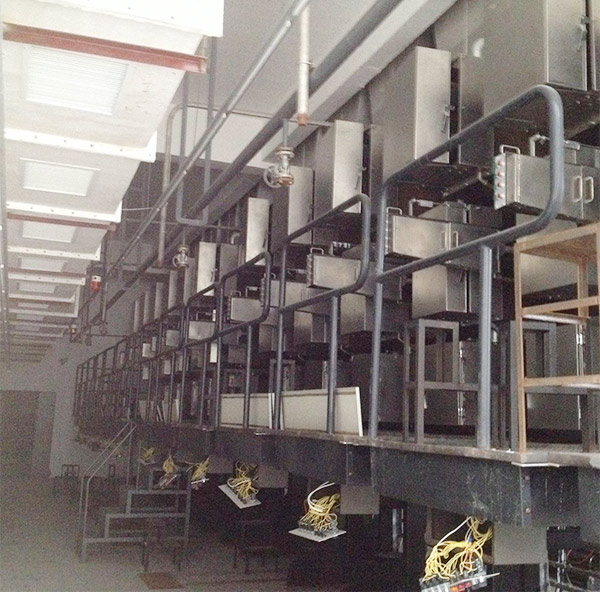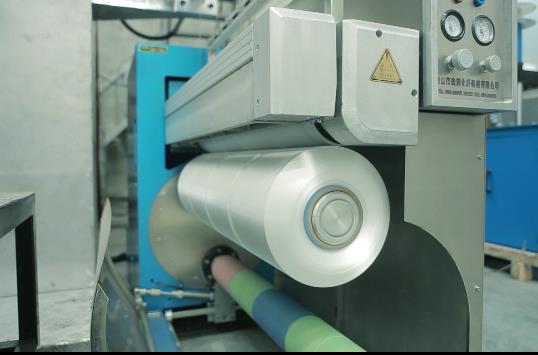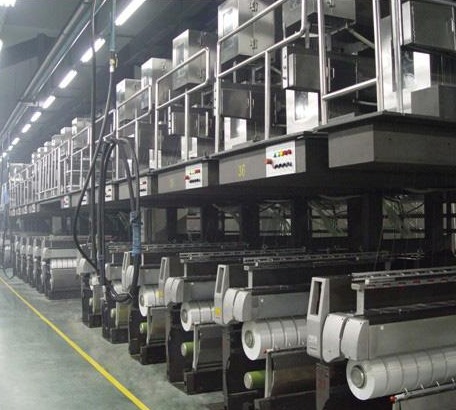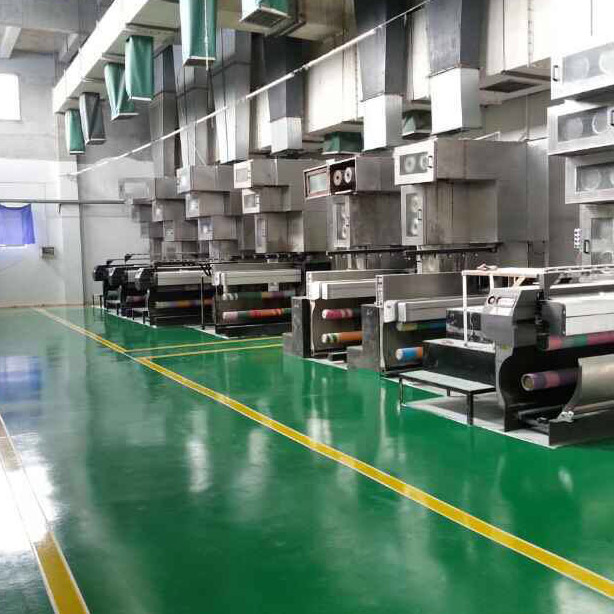- Polypropylene spinning machine
- Polypropylene FDY equipment
- Polyester POY spinning machine
- Polyamide FDY common and high strength equipment
- Polyester FDY equipment
- Polyester high strength equipment
- polyester、Polyamide、 Polypropylene BCF equipment
- Small spinning machine
- All kinds of spinning special parts
- 立冬至,问冬安|富邦化纤机械以匠心蓄能,愿你冬来皆安,岁岁无忧!
- The National Alliance of Model Workers and Skilled Craftsmen Innovation Studios in the Textile Industry was established
- Polypropylene FDY Spinning Machine: Technical Features and Application Fields
- On the Chongyang Festival, we respect the elderly and pass on warmth. Fubang Machinery wishes all our respected elders to bloom like ancient maple leaves and brave the frost like late chrysanthemums!
- The professional attire supply and demand matching conference builds a platform for industrial cooperation
- The polypropylene spinning machine is the core equipment driving industrial upgrading

- Contact:Mr. Huang Guofu
- Cel:0086-13901505556
- Fax:0086-519-83341119
- Email:czfb5556@126.com
- Add:No. 288-8 ChangLi Rd, Huangli Town, Changzhou, JS PRV.
Textile News
The high cotton price situation that started last year has not been effectively relieved so far. The market share of pure cotton products began to shrink, and more cost-effective blended products were replaced, especially viscose staple fibers, which gradually replaced some cotton products.
The difference between domestic and foreign cotton prices narrowed
According to the data monitoring of Mysteel Agricultural Products (000061), as shown in Figure 1, as of April 24, the price of US cotton M1-1/8 to Hong Kong fell by 168 yuan/ton to 23,855 yuan/ton; the average domestic 3128B lint price was temporarily stable , reported 22823 yuan / ton; the difference between domestic and foreign cotton prices narrowed by 168 yuan / ton to -1032 yuan / ton. The US cotton weekly contracted export report data was not good and the US dollar index strengthened, and the foreign cotton price fell slightly with the decline; the fundamentals of the domestic cotton price remained weak. The difference between domestic and foreign cotton prices has narrowed, but the overall situation is still strong on the outside and weak on the inside, and the pattern of short-term cotton prices is maintained. It is expected that the price difference between domestic and foreign cotton will remain within a narrow range.
Supply: According to the Mysteel survey, the national commercial inventory decreased month-on-month, and downstream demand was lower than expected. U.S. upland cotton shipments in 2021/22 were 83,300 tons, a 10% increase from the previous week and a 6% decrease from the previous four-week average, mainly to China (33,300 tons), Pakistan, Turkey, Vietnam and Mexico. U.S. Pima cotton export shipments in 2021/22 were 3,334 tons, a decrease of 19% from the previous week and an increase of 22% from the average of the previous four weeks. The main destinations were India, China (1,179 tons), Turkey, Peru and Taiwan. . The cotton market has been trading sluggishly recently, and the traditional gold three silver four prices have basically failed. The domestic textile market demand continues to be weak, and the market recovery is still unclear. The current cotton sales progress is only 50%, and the pressure on upstream enterprises continues to increase. Epidemic control has a great impact on enterprise transportation and terminal consumption. It is expected that the short-term national commercial inventory will continue to be digested slowly.
Demand: According to China Customs data, in March 2022, my country's textile and apparel exports were US$22.049 billion, a year-on-year increase of 16.79%. Among them, the export value of textiles (including textile yarns, fabrics and products) was 11.825 billion US dollars, a year-on-year increase of 22.39%; the export value of clothing (including clothing and clothing accessories) was 10.224 billion US dollars, a year-on-year increase of 10.92%. At present, the downstream cotton yarn market remains weak, and the follow-up orders are insufficient. The epidemic in some areas has led to the suspension of logistics, and the inventory of finished products has been accumulating. However, recently, the state has issued a document to ensure the smooth flow of logistics, continue to reduce logistics costs, and ensure the stability of the supply chain and industrial chain. Guangdong, Jiangsu, Zhejiang and other coastal areas The consumer demand for cotton yarn in the region rebounded slightly, and the willingness of some cotton yarn traders to stock up at low prices has rebounded.
The impact of the epidemic on Jiangsu textile enterprises
According to the survey, 25.13% of the production and operation of enterprises “dropped by more than 50%”, 18.09% “dropped by 30-50%”, 32.66% “dropped by 20-30%”, and 22.61% “dropped by less than 20%” %, "no obvious impact" accounted for 1.51%. The epidemic has a great impact on the production and operation of enterprises, which deserves attention and attention.
The main difficulties that enterprises are currently facing due to the epidemic:
The survey shows that among all the options, the top three are: "high production and operation costs" (73.37%), "reduced market orders" (66.83%), and "unable to produce and operate normally" (65.33%). more than half. Others are: "It is difficult to collect accounts receivable", "The company needs to pay liquidated damages because it cannot perform the transaction contract on time", "It is more difficult to raise financing" and so on.
Specifically:
1. The cost of production and operation is high, and the burden on the enterprise is heavy
Mainly reflected in: the epidemic has led to obstruction of transportation and logistics, raw and auxiliary materials, equipment materials, etc. cannot come in, products cannot go out, freight rates have increased by as much as 20%-30% or more, and the prices of raw and auxiliary materials have also risen significantly; labor costs have been increasing year by year. Rising, social security and other rigid expenses are very large; rent costs are high, many stores are not operating well, or even closed; corporate epidemic prevention costs increase.
2. Decrease in market orders
Foreign markets: Due to the obstruction of logistics and transportation, the samples and samples delivered to customers cannot be delivered in time, and customers cannot confirm in time, which directly affects the order of large goods. The noodles and accessories could not come in, which caused the order to be interrupted. The goods could not be delivered, and the products were backlogged in the warehouse. Customers were very worried about the delivery time of the orders, and subsequent orders were also affected. Therefore, a large number of foreign customers stopped placing orders and waited and watched. Many orders will be transferred to Southeast Asia and other regions.
Domestic market: Due to the closure and control of the epidemic, orders could not be fulfilled on time, non-local customers could not visit the company normally, business personnel could not carry out sales activities normally, and the loss of customers was serious. In terms of retail, due to irregular closures and controls, shopping malls and stores cannot operate normally, the flow of people in various business districts has plummeted, customers dare not invest easily, and store decoration is hindered. Affected by the epidemic, customers went out for shopping less frequently, wages declined, consumer demand decreased, and the domestic sales market was sluggish. Online sales cannot be delivered on time due to logistics reasons, resulting in a large number of refunds.
3. Unable to operate normally
During the outbreak of the epidemic, due to the closure and control, employees could not arrive at their posts normally, logistics was not smooth, and there were problems in the transportation of raw and auxiliary materials, finished products, etc., and the production and operation of enterprises were basically at a standstill or semi-stop.
Suggestions on countermeasures against the epidemic
1. Make every effort to ensure the smooth flow of logistics
Ensuring the smooth flow of logistics is also an important part of fighting the "hard battle" of epidemic prevention and control. Adequate and timely material supply is not only the "lifeline" for stabilizing people's livelihood and enterprise development, but also related to the "two-handed approach" of epidemic prevention and control and economic development. "The overall situation, the government has issued relevant policies, and strive to ensure that the industrial chain and supply chain "do not drop".
2. Strengthening effective and precise prevention and control of the epidemic
In order to reduce the impact on the normal production and business activities of enterprises, it is recommended that relevant epidemic prevention departments provide door-to-door nucleic acid testing services for units that should be inspected, so as to ensure the normal operation of enterprises, and encourage the restoration of normal exchanges in low-risk areas.
3. Further implement the policy of reducing taxes and fees
In view of the actual difficulties faced by enterprises, it is hoped that the government and relevant departments can provide labor-intensive textile and garment enterprises with measures such as periodic social security reductions and exemptions, and timely launch tax reduction and fee reduction plans, such as tax and fee extension declarations or appropriate reductions and exemptions to reduce the burden on enterprises. Due to the burden and pressure caused by the impact of the epidemic, help enterprises to tide over the difficulties, otherwise many enterprises will die out. At the same time, the policy of benefiting enterprises and people should also take into account the regulated enterprises, which are the "ballast stone" of economic stability. .
4. Increase financial support for enterprises in difficulty
With regard to the current severe situation of resumption of work, production and exports, some enterprises are currently facing difficulties due to the difficulty in capital turnover after the production cycle is prolonged, the lack of working capital, and the need for bank credit support. It is hoped that the financial support policies to fight the epidemic and help the hardships can be better implemented, especially for companies with orders and temporary difficulties in the market.
5. Provide enterprise post stabilization subsidies, employee vocational skills training subsidies, etc.
The textile and garment industry is a traditional labor-intensive enterprise, which has absorbed a large number of social employees and played a positive role in social stability.
Disclaimer: This article is organized from the Internet, and the copyright belongs to the original author; if there is any infringement, please inform in time, and delete it after verification.
- 立冬至,问冬安|富邦化纤机械以匠心蓄能,愿你冬来皆安,岁岁无忧!
- The National Alliance of Model Workers and Skilled Craftsmen Innovation Studios in the Tex
- Polypropylene FDY Spinning Machine: Technical Features and Application Fields
- On the Chongyang Festival, we respect the elderly and pass on warmth. Fubang Machinery wis
- The professional attire supply and demand matching conference builds a platform for indust
- The polypropylene spinning machine is the core equipment driving industrial upgrading
- Management Skills: Unlock New Management Efficiency! Six core strategies to break through
- The 2025 International Advanced Fiber Materials Innovation Conference was held in Shengze
- Polypropylene spinning machine is a key link in the production of synthetic fibers
- When Xiang embroidery meets cheongsam, the two intangible cultural heritages join hands, a




